In this guide, we’ll learn how to plug Bright Data’s Web MCP into ChatGPT Atlas in under 5 minutes and start building AI workflows that actually work with real-world web data.
The problem with AI agents and web data
AI agents are great at reasoning, writing, and analyzing – but terrible at getting fresh data from the web. Here’s why:
- They get blocked: Most websites use bot detection. Standard AI tools can’t get past Cloudflare, CAPTCHAs, or rate limits.
- They can’t parse complex sites: Dynamic JavaScript apps, infinite scroll, lazy loading – these break traditional scrapers.
- They waste your time on structure: You spend hours writing code to extract product prices or anything else instead of using the data.
- They work with stale data: ChatGPT’s training data has a cutoff date. Without real-time access, your agent is flying blind.
Bright Data’s Web MCP server solves all of this. It’s battle-tested infrastructure (used by Fortune 500 companies) packaged as a simple MCP connector that works with ChatGPT Atlas right out of the box.
What makes Bright Data’s Web MCP different?
1. Never get blocked
Built on Bright Data’s global residential proxy network with 195+ countries coverage. Your requests look like they’re coming from real users. Works on sites that block AWS, Google Cloud, and every other data center IP range.
2. 60+ platforms, pre-built
Why waste time scraping LinkedIn when there’s a dedicated extractor? Same for Amazon, Instagram, TikTok, Facebook, Google Maps, YouTube, Reddit, Zillow, Booking.com, and 50+ others. Get structured JSON instead of messy HTML.
3. Full browser automation
Not just HTTP requests – real Chrome browsers that can click buttons, fill forms, scroll pages, and handle any JavaScript-heavy site. Take screenshots, wait for elements, extract network traffic.
4. Free to start
5,000 requests per month, free forever. No credit card required. Enough for serious testing and everyday use.
5. Two-mode system
- Rapid mode (free): Fast scraping, search results, markdown conversion
- Pro mode: Everything above + 60+ platform extractors + full browser automation
Most competing Web MCP servers give you one or the other. Bright Data gives you both.
Setting up Bright Data MCP in ChatGPT Atlas
What you need
- ChatGPT account (any tier works)
- Bright Data account
- 2 minutes of your time
The setup (seriously, it’s fast)
Step 1: Get your credentials
After signing up for Bright Data, you’ll receive an API token via email. Can’t find it? Go to your account settings and grab it there. It looks like this: 2dceb1aa0123456789abcdef
Step 2: Build your connection URL
Here’s your Web MCP server endpoint:
https://mcp.brightdata.com/sse?token=YOUR_API_TOKENJust replace YOUR_API_TOKEN with your actual token.
Want the advanced features (platform extractors + browser automation)? Add &pro=1:
https://mcp.brightdata.com/sse?token=YOUR_API_TOKEN&pro=1Step 3: Plug it into ChatGPT
- Open ChatGPT settings (click your profile picture)
- Go to Apps and connectors → Advanced settings
- Turn on Developer mode
- Click Create (to add a new connector)
- Fill in:
- Name: “Bright Data” (or whatever you want)
- Description: “Real-time web data and scraping infrastructure”
- URL: Paste your endpoint from Step 2
- Hit Create and authorize the connection
Step 4: Open Atlas and test it
Click the Atlas browser icon in ChatGPT. Try this:
“Search Google for ‘best mechanical keyboards 2025’ and show me the top 5 results with prices”
Watch as ChatGPT uses Bright Data to fetch real-time search results and extract the data. No blocking, no errors, just results.
Real workflows you can build today
Workflow 1: Competitive intelligence dashboard
Scenario: You’re tracking competitor pricing across Amazon, eBay, and Walmart.
The prompt:
Monitor these product URLs for price changes:
- [Amazon URL]
- [eBay URL]
- [Walmart URL]
Check them daily and alert me if prices drop by 10% or more.What happens: ChatGPT uses web_data_amazon_product, web_data_ebay_product, and web_data_walmart_product to extract current prices. No HTML parsing, no broken selectors when sites update.
Workflow 2: LinkedIn lead generation
Scenario: You need decision-makers from Series A startups in fintech.
The prompt:
Find companies on LinkedIn matching:
- Industry: Financial Services
- Funding: Series A
- Location: San Francisco
For each company, extract:
- Company name and employee count
- Recent job postings (especially C-level roles)
- Employee profiles for founders and VPsWhat happens: ChatGPT chains web_data_linkedin_company_profile, web_data_linkedin_job_listings, and web_data_linkedin_people_search to build your lead list. Structures the data into a spreadsheet automatically.
Workflow 3: Social media sentiment analysis
Scenario: You’re launching a product and want to track social buzz.
The prompt:
Search X (Twitter) and Reddit for mentions of "ProductName" in the last 24 hours.
Extract post content, engagement metrics, and sentiment.
Create a summary report.What happens: ChatGPT uses web_data_x_posts and web_data_reddit_posts to gather mentions, then analyzes sentiment using its built-in reasoning. All in one workflow.
Workflow 4: Dynamic form filling
Scenario: You need to submit data to a web portal that requires login and multi-step forms.
The prompt:
Go to [portal URL], log in with [credentials], navigate to the submission form,
fill in these fields: [data], and submit. Take screenshots at each step.What happens: ChatGPT uses the scraping_browser_* tools to:
scraping_browser_navigateto open the sitescraping_browser_type_refto fill login formscraping_browser_click_refto click through stepsscraping_browser_screenshotto document the process
No Selenium scripts, no Puppeteer code. Just natural language.
Understanding what’s under the hood
When you connect Bright Data MCP, you’re getting access to 60+ specialized tools across three categories:
General web scraping (Rapid mode – FREE)
search_engine– Google, Bing, Yandex resultsscrape_as_markdown– Any webpage → clean textscrape_as_html– Raw HTML with unblockingscrape_batch– Up to 10 URLs at oncesearch_engine_batch– Run up to 10 searches in parallelextract– AI-powered data extraction from any pagesession_stats– Track your tool usage
Platform-specific extractors (Pro mode)
49 specialized tools for:
- E-commerce: Amazon (products, reviews, search), eBay, Walmart (products, sellers), Best Buy, Etsy, Zara, Home Depot
- Social media: Instagram (profiles, posts, reels, comments), TikTok (profiles, posts, shop, comments), Facebook (posts, marketplace, reviews, events), X/Twitter, Reddit, YouTube (videos, profiles, comments)
- Professional networks: LinkedIn (person profiles, company profiles, job listings, posts, people search)
- Real estate: Zillow property listings
- Travel: Booking.com hotels, Google Maps reviews
- Business data: Crunchbase companies, ZoomInfo profiles, Yahoo Finance
- App stores: Google Play Store, Apple App Store
- Shopping: Google Shopping
- News: Reuters articles
- Developer tools: GitHub repository files
Browser automation (Pro mode)
13 powerful automation tools:
- Navigate pages (forward/back)
- Click elements by reference
- Fill forms and type text
- Take screenshots (full page or viewport)
- Scroll and wait for elements
- Monitor network requests
- Extract page HTML or text
- Capture ARIA snapshots for accessibility
Each tool is documented with examples at docs.brightdata.com/mcp-server/tools.
Cost and limits: what you actually pay
Free tier (Rapid mode)
- 5,000 requests/month – resets monthly
- General scraping tools only (7 tools)
- Perfect for: research, content gathering, SERP analysis
- No credit card required
Pro mode
- Pay-as-you-go after free tier
- Access to all 60+ platform extractors and browser automation
- Pricing varies by tool (typically $0.001-$0.01 per request)
- Monitor usage in your dashboard
Pro tip: Start with Rapid mode. Only upgrade to Pro when you need platform extractors or browser automation. Most use cases work fine on the free tier.
Debugging and monitoring
Everything that happens through your MCP connection is logged in your Bright Data dashboard:
What you can see:
- Real-time request logs (URL, status, response time)
- Tool usage breakdown (which tools get called most)
- Error tracking (blocked requests, timeouts, API errors)
- Cost tracking (how much you’re spending)
- Rate limit monitoring
Where to find it: brightdata.com/cp/zones
Common issues:
- “Tool not found” → You’re using a Pro tool in Rapid mode. Add
&pro=1to your URL. - “Rate limit exceeded” → You’ve hit your monthly quota. Upgrade or wait for reset.
- “Invalid token” → Check your API token in settings.
Taking it further
Once you’re comfortable with the basics, explore these resources:
- GitHub repository – Source code, issues, contributions
- Live playground – Test tools without writing code
- Community examples – Real projects from other developers
- Other MCP clients – Use Bright Data with Claude, Cursor, VS Code, LangChain, n8n, and more
Why this matters
We’re entering a new era where AI agents don’t just chat – they do things. But “doing things” requires access to real-world data, and most of that data lives on the web.
Bright Data’s Web MCP server is one of the most powerful implementations of this standard because it doesn’t just connect AI to the web – it removes every barrier that normally stops automation: blocks, CAPTCHAs, rate limits, complex site structures, dynamic content.
The result? AI workflows that actually work in production, not just in demos.
Ready to start? Sign up for Bright Data, grab your API token, and plug it into ChatGPT Atlas. Your first 5,000 requests are on us.
Questions? Check the FAQ or contact support.







